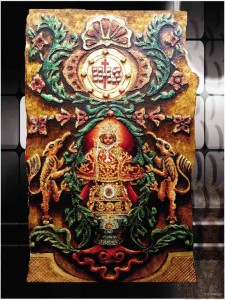
Without a doubt, the most popular and most widespread Catholic devotion in the Philippines is the Santo Niño, the devotion to the Holy Infant of Jesus. Proof of this is that while having originated from the Visayas, it has fanned out to all the ends of the archipelago.
Even in imperial Manila, where the metropolitan press is mesmerized by the Black Nazarene, which it covers like a cliché, there are the pandemonium festivals of the Santo Niño de Tondo and the Santo Niño de Pandacan, all three feasts occurring in January.
The mother of all Santo Niño feasts, of course, is the Santo Niño de Cebu, which the metropolitan press hardly covers. What it covers is the Sinulog, the crass Imeldific street festival of sound and fury signifying nothing.
Thank God then that for the Santo Niño of Cebu, there’s a second celebration every April 28, and it is even more meaningful for Philippine history than the earlier feast.
For while January is ordained by the universal Church as the Feast of the Holy Infant of Jesus and thus the event is celebrated around the world, April 28 is the feast of the “Kaplag,” a Cebuano term for “the finding,” much like the fifth chaplet of the Joyful Mysteries of the Holy Rosary; it refers to the finding of the Santo Niño, the same image given by Magellan to Isabela, the wife of Humabon, after their Christian conversion in 1521, the gesture that’s relived by the Sinulog every year, the same image that was recovered when the Spaniards returned in 1565. The ikon was retrieved by Juan Camus, a soldier of Miguel Lopez de Legazpi, from a burned hut where the Basilica Minore de Santo Niño de Cebu of the Augustinians stands today.
The omnipresence of the Santo Niño devotion in Cebu and elsewhere around the country and the globe is prefigured in “Kaplag: Expressing the Face of Jesus in Art in the Year of Faith 2013,” an art exhibit of multimedia paintings at the SM Cebu Art Center by Augustinian friar-artist Fr. Dominador Besares. (The exhibit’s opening was graced by Cebu Archbishop José Palma and Fr. Eusebio Berdon, prior provincial of the Philippine province of the Augustinians, whose headquarters is in Cebu.)
Iconography
The 27 works on exhibit (on show until May 31) mainly depict the holy image set amid key architectural leitmotivs of Cebu and the churches, many of them dedicated to the Santo Niño.
Father Besares, who took up Fine Arts at the Philippine Women’s University, situates the Holy Infant in the context of the houses of worship that enshrine them. The results are as much studies in iconography as in Hispanic colonial architecture.
To some extent, Besares continues the peculiar Philippine painting genre of old churches. But while the works of Al Perez, Danny Pangan and Manuel Baldemor sought to define the baroque outlines and massive masonry of colonial churches, which would be another form of landscape painting, Besares goes for baroque detailing, an attempt at specificity to connote a larger whole.
A physician-artist, Dr. Dante Lerma of the University of Santo Tomas Hospital, has also been doing baroque detailing of old colonial churches and structures in his works. Both Lerma and Besares seem to attempt to connect key and even incidental details of architecture with the larger whole.
The larger whole is not alone the massive churches that the Augustinians and other intrepid missionary orders built in Visayas and elsewhere. It is also the wholeness and catholicity of the faith that has been imbibed by the Visayans and other Filipinos.
To some extent, the intricate detailing of art and architecture, especially since they derive from baroque Europe and colonial Mexico, become hybrid when transposed to the Philippine setting.
In fact, the riot of colors that Fray Besares evokes in his depictions seems particularly predisposed to blind and enthrall like the colors of the tropical sun. One looks for rhyme and reason in the conceit of combining European rococo and Philippine festive bedlam; but both contrasting sensibilities somehow cohere in Besares’ very confident art.
His artistic confidence is infectious and should embolden every Visayan and Catholic, especially since Cebu is the cradle of Christianity in the Philippines and the country is marking a historic milestone in 2015.
In fact, the “Kaplag” that’s being celebrated this year is the 448th since 1565. In two years, Cebu and the rest of the Philippines will be celebrating the 450th anniversary of not only the Augustinian presence in the archipelago, but also the Christianization of the Philippines.